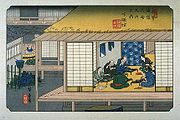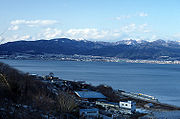
Shimosuwa-shuku
Encyclopedia


69 Stations of the Nakasendo
The are the rest areas along the Nakasendō, which ran from Nihonbashi in Edo to Sanjō Ōhashi in Kyoto. The route stretched approximately and was an alternate trade route to the Tōkaidō.-Stations of the Nakasendō:...
of the Nakasendō
Nakasendo
The , also called the , was one of the five routes of the Edo period, and one of the two that connected Edo to Kyoto in Japan. There were 69 stations between Edo and Kyoto, crossing through Musashi, Kōzuke, Shinano, Mino and Ōmi provinces...
, as well as being the ending location of the Kōshū Kaidō
Koshu Kaido
The was one of the five routes of the Edo period and it was built to connect Edo with Kai Province in modern-day Yamanashi Prefecture, Japan. The route continues from there to connect with the Nakasendō's Shimosuwa-shuku in Nagano Prefecture...
. It is located in the present-day town of Shimosuwa
Shimosuwa, Nagano
is a town located in Suwa District, Nagano, Japan. It is located on Lake Suwa, a large, natural lake surrounded by mountains.As of 2006, the town has an estimated population of 22,421. The total area is 66.90 km²....
, Suwa District
Suwa District, Nagano
is a district located in Nagano, Japan.As of 2003, the district has an estimated population of 46,162 and a density of 181.18 persons per km². The total area is 254.79 km².-Towns and villages:*Fujimi*Hara*Shimosuwa...
, Nagano Prefecture
Nagano Prefecture
is a prefecture of Japan located in the Chūbu region of the island of Honshū. The capital is the city of Nagano.- History :Nagano was formerly known as the province of Shinano...
, Japan
Japan
Japan is an island nation in East Asia. Located in the Pacific Ocean, it lies to the east of the Sea of Japan, China, North Korea, South Korea and Russia, stretching from the Sea of Okhotsk in the north to the East China Sea and Taiwan in the south...
.
History
First built around 1601, Shimosawa-shuku flourished as a post town because it was located between two difficult mountain passes, Wada Pass and Shiojiri Pass. The town's onsenOnsen
An is a term for hot springs in the Japanese language, though the term is often used to describe the bathing facilities and inns around the hot springs. As a volcanically active country, Japan has thousands of onsen scattered along its length and breadth...
s made it a heavily used rest area. It also served as the entrance to the Suwa Taisha
Suwa Taisha
, or Suwa Grand Shrine, is a Shinto shrine in Nagano prefecture, Japan. Over 1200 years old, it is one of the oldest shrines in existence, and is mentioned in the Kojiki, an 8th century text...
.
Records show that in 1843, Shimosuwa-juku had 1,345 residents and 315 buildings. Among the building, there was one honjin
Honjin
thumb|250px|The honjin at [[Inaba Kaidō]]'s [[Ōhara-shuku]]. is the Japanese word for an inn for government officials, generally located in post stations during the later part of the Edo period.-Evolution of Honjin:...
, one sub-honjin, and 40 hatago
Hatago
were Edo period lodgings for travelers at shukuba along the national highways, including the Edo Five Routes and the subroutes. In addition to a place to rest, hatago also offered meals and other foods to the travelers...
.
Neighboring post towns
Nakasendō- Wada-shukuWada-shukuwas the twenty-eighth of the sixty-nine stations of the Nakasendō. Its present-day location is in the Wada section of the town of Nagawa, in the Chiisagata District of Nagano Prefecture, Japan.-History:...
- Shimosuwa-shuku - Shiojiri-shukuShiojiri-shukuwas the thirtieth of the sixty-nine stations of the Nakasendō. It is located in the central part of the present-day city of Shiojiri, Nagano Prefecture, Japan.-History:This area was originally built by Ōkubo Nagayasu in the Keichō era of the early Edo period...
Kōshū Kaidō
- Kamisuwa-shuku - Shimosuwa-juku (ending location)

